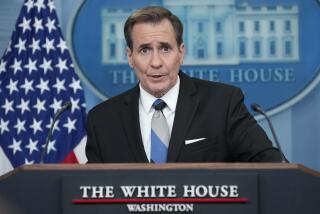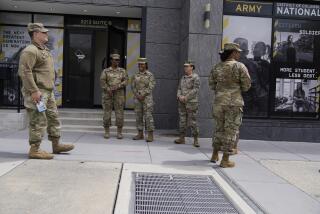U.S. to reduce nuclear weapons stockpile
The Bush administration said Tuesday that it would make a 15% reduction in the nation’s stockpile of nuclear weapons, taking the overall inventory down to less than a quarter of its size at the end of the Cold War in 1991.
A major effort to retire older weapons was accomplished five years ahead of schedule, allowing the new round of cutbacks, said Thomas P. D’Agostino, chief of the National Nuclear Security Administration. The additional cuts would be done by 2012.
The overall size of the nation’s nuclear inventory is classified. But under the terms of a 2002 treaty, the U.S. and Russia are committed to reducing deployed weapons on missiles and aircraft to between 1,700 and 2,200 by 2012.
It is believed the U.S. holds about 4,000 additional weapons in reserve status, though those numbers are classified.
Separately, the Energy Department on Tuesday unveiled a long-term plan to modernize and reduce the size of its weapons research and production complex, saying it would cut about 20% of its current 37,000 workers and close about one third of its facilities.
The plan would eliminate about 300 jobs in nuclear weapons work at Lawrence Livermore National Laboratory in the Bay Area, a bomb design center that has an 8,000-member work force involved in a wide range of research. About half of those cuts have already occurred, said Bruce Goodwin, chief of the weapons program at the lab.
“We have seen this coming for some time,” Goodwin said.
The cutbacks at Livermore would also reduce by 90% the acreage devoted to nuclear weapons work, mainly because weapons research activities would stop at Site 300, about 17 miles east of the one-square-mile main laboratory site.
Other similar cuts are being made at the National Nuclear Security Administration’s sites near Amarillo, Texas and in Albuquerque; Los Alamos, N.M.; Oak Ridge, Tenn.; and Aiken, S.C., among others.
The announcement comes days after the House Appropriations Committee cut all funding for a new hydrogen bomb, known as the reliable replacement warhead. The proposed cuts still must be approved by the full Congress.
D’Agostino said the consolidation and modernization is needed with or without the new warhead program, which is being developed at Livermore. He said the smaller complex and updated facilities are necessary to fulfill the continued need for nuclear weapons and could be accomplished with no new funding.
The agency will release a draft supplemental environmental impact statement for public comment next month.
More to Read
Sign up for Essential California
The most important California stories and recommendations in your inbox every morning.
You may occasionally receive promotional content from the Los Angeles Times.











